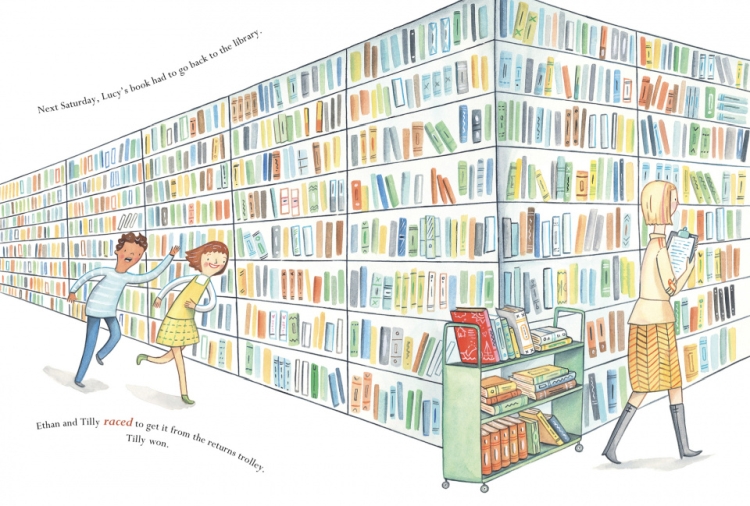
Get the latest updates in your inbox and sign up for more info!
Author Natalie Jane Prior talks about “Lucy’s Book”, the picture book she created with Cheryl Orsini, featured in the BCBF online exhibition A UNIVERSE OF STORIES - Starring: the Book.
One of the most important decisions of my life took place in a school library. It happened in Brisbane, Australia, about 1973. An ordinary sort of day. I headed for the library as soon as my lunch was eaten and, standing by the circulation desk, I looked at the shelves full of books and made myself a promise.
When I grow up, I told myself, I am going to be a writer. Other people might think it’s better to write for grown ups, but I’m not going to betray kids. I’m not going to write dumb books for grown ups. I’m going to write children’s books, and one day, my books are going to be on the shelves of this library.
Look at Lucy as Cheryl Orsini has depicted the character in the illustrations for Lucy’s Book, change her blonde hair to dark brown, and you see a portrait of me as I stood mapping my future with surprising accuracy for a nine-year old. Even then, I was pig-headed and passionate about children’s books. My universe was centred somewhere between the school library and the one operated by the local council. Many of my formative reading experiences came from library books. That I should grow up and become a librarianand writer myself, seems like an inevitable sequel.
Working as a public librarian in a disadvantaged area taught me that books of all kinds are an incredibly important part of life for many, many people. I saw cheap fiction help borrowers through the most appalling personal pain. I met men and women whose entire education came out of the books on our shelves. And every day I encountered ordinary book lovers who would not only tell me what they liked, but how, why, where and when they read. Observing the nuances of the borrowers’ interactions with their books was always the most interesting part of my job, and posed in turn a question I found endlessly fascinating: what happened to the books when they went out the library door?
Most library books pass through a large number of hands, and anyone who has ever worked on a circulation desk will confirm that they regularly come back full of sand or crumbs, or with pages swollen from being left out in the rain or dropped in the bath. Others will be surreptitiously slipped into the book drop with chewed corners, snipped out sections, or mysterious hieroglyphics on the title pages that tell individual borrowers which books they’ve already read. Unusual bookmarks (bills, train tickets or boarding passes, the occasional medical result) sometimes give staff a clue about where books have been. And of course, there are always the books that come back with neatly folded strips of toilet paper projecting from between the pages—but perhaps the less said about those, the better.
The germ of Lucy’s Book, which traces the life of a favourite library book through a community—from the first time it’s borrowed by a little girl called Lucy, to the day it ends up at the library book sale and is taken home by her for good—came out of this lifetime’s experience of libraries, from both sides of the circulation desk. Like a lot of my ideas, it washed around in the back of my head for years, lacking the trigger to finally push it into words. This came with the advent of ebooks. As I found myself adapting to the idea of reading electronically, I ended up doing a lot of soul-searching about the nature of my relationship with the printed word. Like most bibliophiles, I do have a gut reaction whenever I walk into a bookshop or library, and nothing distresses me more than visiting a bookless home. So, I realised, yes, there is something visceral and special, about the look, the feel, the smell, of the printed page. In the end, then, this is really what Lucy’s Book is about—our relationship with the physical book, distilled through my lifetime’s experience of, and love for reading and libraries.
Lucy’s Book is a story for everybody who has ever loved a book with all their heart. It’s an extremely personal text, and for this reason the characters are named after the nieces, nephews and godchildren who I hope will grow up to love reading as much as I do. My artistic partnership with Cheryl Orsini goes back many years, and she has woven her usual illustrative magic around my text, bringing Lucy's world as vividly to life as if she'd visited it. Her illustrations glow with colour and joy, appropriate, as the name Lucy itself means light. May the light of libraries shine on, for generations to come.
by Natalie Jane Prior
(Some of the material in this article was previously published in Magpies Magazine)